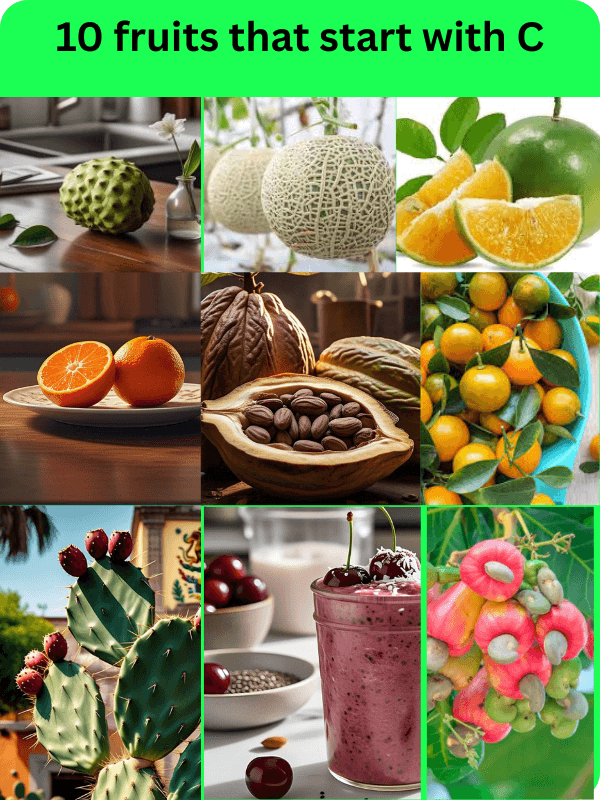As we all know, fruits are nature’s vibrant and delicious gifts. Fruits are blessed with nutrients, taste, flavours, and many health benefits necessary for humanity. This blog will go through 10 fruits that start with C.
So, are you ready to discover fruits’ unique characteristics, nutritional value, health benefits, cultivation, harvesting process, and a delicious recipe for each fruit? Whether you are a food lover, a health-conscious eater, or just curious about discovering tropical and exotic fruits, this guide has something for you.
- List of Fruits that Start with C:
- 1. Cacao Fruit (Theobroma cacao)
- 2. Cactus pear (Opuntia ficus-indica):
- 3. Calamansi (Citrofotunella microcarpa)
- 4. Cantaloupe (Cucumis melo var. cantalupensis)
- 5. Cape Gooseberry(Physalis peruviana)
- 6. Carambola (Star Fruit)- Averrhoa carambola
- 7. Cashew Apple (Anacardium occidentale)
- 8. Cherimoya (Annona cherimola):
- 9. Cherry (Prunus avium)
- 10. Clementine (Citrus × clementina)
List of Fruits that Start with C:
- Cacao
- Cactus Pear
- Calamansi
- Cantaloupe
- Cape Gooseberry
- Carambola (Star Fruit)
- Cashew Apple
- Cherimoya
- Cherry
- Clementine
- Cloudberry
- Coconut
- Crabapple
- Cranberry
- Cupuacu
- Custard Apple
- Citron
- Cavendish Banana
- Capulin Cherry
- Cara Cara Orange
- Ceylon Gooseberry
- Chico Fruit
- Chilean Guava
- Chupa Chupa
- Coco Plum
- Coffee Cherry
- Cornelian Cherry
- Cortland Apple
- Crowberry
- Canary Melon
- Caper Berry
- Cattley Guava
- Cedar Bay Cherry
- Cempedak
- Ceylon Olive
- Cluster Fig
- Cocky Apple
- Coco de Mer
- Conkerberry
- Cicla
- Coruba
- Cacay
- Cedar Apple
- Calamondin
- Camu Camu
- Chalta
- Chestnut (technically a nut, but often used like a fruit)
- Cocona
- Currant (black, red, white)
- Crab Plums
Although there are many fruits that start with C, we have the list of 50 fruits, lets discover first 10 fruits start with c and learn in more detail.
1. Cacao Fruit (Theobroma cacao)
Now we discover the cacao fruit’s description, history, health benefits, nutritional facts, industrial uses, and a delicious recipe.
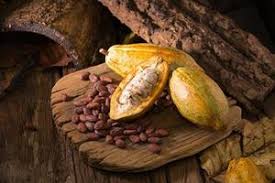
Discover the Description of Cacao Fruit:
The Cacao fruit is uniquely oblong-shaped with a thick, rigid shell. Usually, Cacao fruit is available in four colours: the colour variations are green, yellow, purple, and maroon. Inside, the pulp is sweet and tangy, surrounding cacao beans; these beans are later processed to prepare the chocolate.
History and Origin of Cacao Fruit:
The fruit historian says Cacao’s origins trace back to the lush green tropical rainforests of the Amazon basin in South America. Therefore, archaeological investigations suggest that humans have used cacao fruit for centuries, like in early civilizations, the Olmecs, and Maya in Mesoamerican history, indicating Cacao’s cultivation and consumption.
The historical indications show that Maya and Aztec civilizations held cacao fruit in high esteem; they believed that cacao was nature’s countless gift, so they used cacao beans to make a juice, which is a bitter and frothy drink that they called “xocolatl.” This frothy drink was specially reserved for rituals, ceremonies and the members of the elite class.
You know the economic and social importance of Cacao in past civilizations. Mesoamerican civilizations used cacao beans as a form of currency. Spanish conquistadors encountered Cacao in the early 16th century. They brought it back to Europe, where it gradually became popular and became the sweet treat we know today.
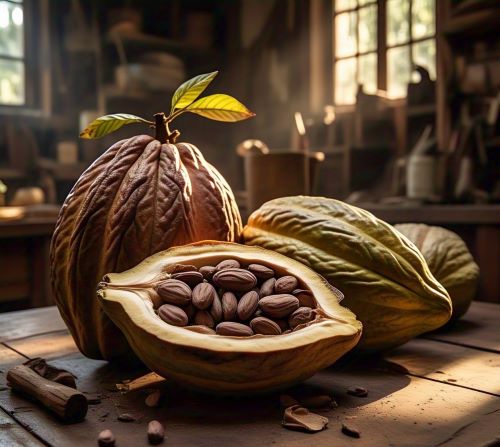
Trivia: Theobroma” Cacao—”Food of the Gods”
- The scientific name of Cacao is Theobroma cacao, which is taken from Greek words where “theos means (GOD) and the word “broma” stands for (FOOD), so we read it together as “ The food of the Gods” This name reflects the reverence with which ancient Mesoamerican cultures regarded Cacao.
- The name Carl Linnaeus, whom we know as the father of modern taxonomy, gave Cacao its name. He was so impressed with the fantastic cacao plant and its unique uses. Therefore, he gave it a divine name.
- As we read before, Mesoamerican civilization prepared a drink, “xocolatl”, which they often mixed with spices like chilli peppers and vanilla, considered a potent and invigorating beverage.
- The process of fermenting, drying, and roasting cacao beans to develop their characteristic flavour was a sophisticated technique developed by ancient Mesoamerican cultures.
Cacao’s Nutritional Facts (Per 100g)
- Calories: 228 kcal
- Carbohydrates: 57 g
- Protein: 14 g
- Fat: 13 g
- Iron: 6 mg
- Magnesium: 500 mg
- Antioxidants: High
Health Benefits of Cacao Fruit:
- The cacao fruit is Rich in antioxidants, which fight free radicals.
- The fruit includes elements that boost mood and reduce stress with natural theobromine.
- Supports heart health by improving blood circulation.
Cacao’s Uses in Healthcare and Beauty Industries:
Healthcare Industry:
Cacao fruit is a top choice for healthcare industries because of its rich antioxidant and anti-inflammatory elements. It contains flavonoids, polyphenols, and other important minerals like magnesium and iron, which are beneficial sources for making medicines for cardiovascular health. Moreover, cacao fruit has properties like theobromine and phenylethylamine, which are used as a natural remedy for stress and anxiety.
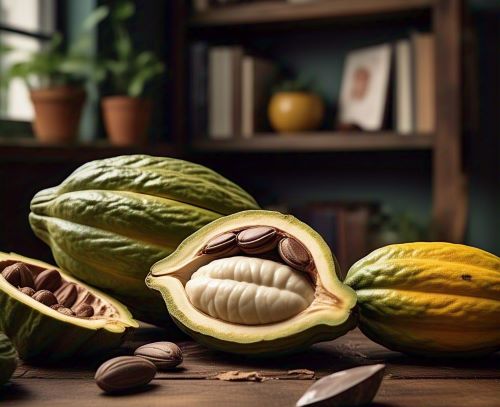
Beauty Product Industry:
- Moisturizing Properties: Most skin products like lotions, creams, and balms that fight against skin dryness and enhance skin texture are made from cacao butter extracted from cacao beans. This natural emollient deeply moisturizes the skin.
- Skin Smoothing: Cacao can also help improve skin elasticity and minimize the possible appearance of wrinkles; cacao fruit contributes to a smoother, more youthful complexion.
- Hair Care: You can use cacao butter in hair care products to give your hair shine, moisture, and strength.
- Body Scrubs and Masks: Body scrubs and masks exfoliate using ground cacao beans. The fine grains easily remove dead skin cells from the body, while the antioxidants nourish and revitalize the skin.
The Cacao Fruit Cultivation & Harvesting Process:
The Cacao fruit trees naturally grow in tropical climates with consistent rainfall. The cacao fruit trees usually take 3 to 5 years to mature and bear their fruit. We manually harvest cacao by cutting the pods, extracting the beans, and fermenting them for processing.
Recipe: Homemade Hot Chocolate:
Ingredients:
- 2 tbsp raw cacao powder
- 1 cup milk (or plant-based alternative)
- 1 tbsp honey or maple syrup
- ½ tsp vanilla extract
- A pinch of cinnamon
How to Make:
- Heat the milk in a saucepan over medium heat.
- Stir in the cacao powder, sweetener, vanilla, and cinnamon.
- Whisk continuously until smooth and heated through.
- Pour into a mug and enjoy!

2. Cactus pear (Opuntia ficus-indica):
Now we discover the cactus pear fruit’s description, history, health benefits, nutritional facts, industrial uses, and a delicious recipe.
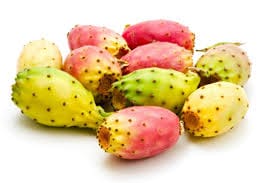
The Description of Cactus Pear Fruit:
The one fruit has different names, like cactus pear, also known as prickly pear and Opuntia, which is the nopal cactus fruit. The Cactus pear fruit has a vibrant, oval-shaped exterior; it has five colors ranging from green to yellow, orange, red, and deep purple, usually depending on the variety and ripeness.
The fruit’s outer skin is almost covered in tiny, hair-like spines (glochids), so you should carefully remove these glochids for consumption. Inside the fruit is the juicy, sweet flesh speckled with tiny, edible seeds, varying in colour from white to deep red or purple.
The Origin and History of Cactus Pear:
When we search for cactus pear, where it originally belonged, we find that it is primarily native to arid and semi-arid lands of the Americas and is mainly grown in Mexico and the southwestern areas of the United States.
The Aztecs (Mesoamerican civilization), from the 15th to 16th centuries, cultivated and consumed fruit for centuries; they used it as a staple in their diet and for medicinal purposes.
Spanish conquistadors conquered the Aztecs in the middle of the 15th century. They introduced cactus pear to Europe, Africa, and Asia, where it adapted well to similar dry climate regions.
Cactus pear fruit plays a massive role in local cultural diets and traditional medicines. Today, the fruit is widely grown in Mexico, the Mediterranean, South America, and many parts of Africa.
Trivia: A Symbol of Resilience
- The cactus fruit is grown in Opus, a city in Greece, where a similar plant once thrived.
- Mexico’s national symbol is the prickly pear cactus (tuna) or nopal cactus, which appears on its coat of arms.
- The fruit frequently produces natural dyes in shades of red and purple.
- The betalains in some cactus pear’s varieties give them vibrant colors and antioxidant properties.
Nutritional Facts (Per 100g)
- Calories: 41 kcal
- Carbohydrates: 9 g
- Protein: 0.7 g
- Fat: 0.5 g
- Fibre: 3.6 g
- Vitamin C: 14 mg
- Calcium: 56 mg
- Magnesium: 85 mg
- Antioxidants: High
Cactus pear has the following health benefits:
- Rich in Antioxidants: Helps the human body fight oxidative stress and inflammation problems.
- Supports Digestion: Cactus pears contain high fiber, which promotes gut health and prevents constipation problems.
- Regulates Blood Sugar: Cactus pear may help lower blood sugar (BP) levels, which benefits those with diabetes.
- Boosts the Body’s Immune System: Cactus pear, or prickly pear, contains vitamin C. This vitamin strengthens the body’s defense against viral infections and various diseases.
- Heart Health: Helps lower bad cholesterol (LDL) and supports healthy blood pressure.
Cactus Pear’s Uses in the Healthcare and Beauty Sector:
Healthcare Industry:
- Blood Sugar Control: Studies suggest that cactus extract (prickly pear) may help reduce blood sugar spikes in people with type 2 diabetes.
- Anti-Inflammatory Properties: Pharmaceutical companies traditionally use cactus to treat stomach ulcers, wounds, and infections.
- Hydration and Detoxification: Cactus pear is always central to hydration and detox drinks because it has high water content and antioxidants.
The beauty product industry uses
- Moisturizing Elements: The oil obtained from the seeds of cactus pears is high in vitamin E and essential fatty acids. Therefore, it is an excellent natural skin moisturizer.
- The high antioxidant content included in this fruit helps reduce facial wrinkles and fine lines.
- Skin-Soothing Property: Cactus pear gel soothes irritated and dry skin in soothing lotions.
Cultivation & Harvesting of Cactus pear:
Cactus pears thrive in hot and dry climates and require little water. They are ideal for areas suffering from drought. The plants grow in well-drained, sandy, or rocky soils and produce fruit within 1 to 2 years after planting.
Hand harvesting with gloves is beneficial to avoid irritating spines. Before eating, brush or clean the fruit to remove any remaining glochids.
Recipe: Refreshing Cactus Pear Juice
Ingredients:
- 2 ripe cactus pears
- 1 cup cold water
- 1 tbsp honey (optional)
- Juice of 1 lime
- Ice cubes
How to Make:
- Carefully peel the cactus pears, removing the outer skin.
- Blend the flesh with water until smooth.
- Strain the juice to remove seeds (optional).
- Stir in lime juice and honey, then pour over ice.
- Enjoy a refreshing, antioxidant-rich drink!
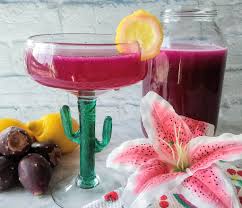
3. Calamansi (Citrofotunella microcarpa)
Now we discover the calamansi fruit’s description, history, health benefits, nutritional facts, industrial uses, and a delicious recipe.
Calamansi fruit Light Description
When we visit the southern area of Asian countries, we Generally witness small, shaped like round ball citrus fruits with tangy, acidic tastes; you find this fruit in almost every fruit market. This fruit is called Calamansi fruit, also known as Philippine lime. The fruit is about 2 to 3 cm thin, with green-to-orange skin when ripe. The Calamansi fruit is widely used in Asian cuisine, natural remedies, and beauty products.
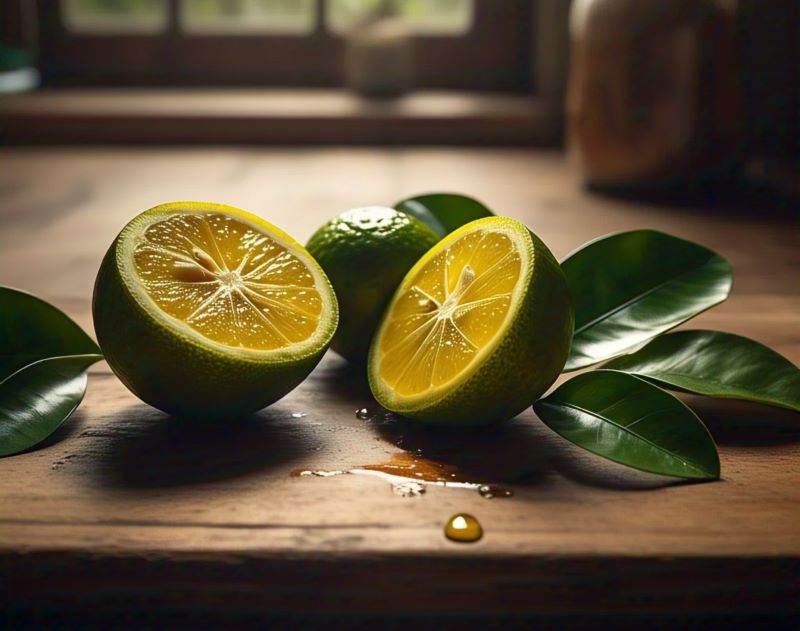
Origin and History of Calamansi fruit:
Calamansi is indigenous to Southeast Asia and the Philippines. This hybrid fruit is a cross between the mandarin and the kumquat. It has been cultivated for many centuries.
It was traditionally and culturally used in Filipino medicine and cuisine, but spread to Malaysia and Indonesia. Calamansi fruit is now widely grown throughout tropical and subtropical areas for its health benefits and citrusy flavor.
Trivia: The Tiny Citrus Powerhouse
- Calamansi is occasionally called “golden lime” because it has high vitamin C content.
- The calamansi fruit is also used in skincare to lighten dark spots and acne scars.
Nutritional Facts (Per 100g)
- Calories: 37 kcal
- Vitamin C: 88 mg
- Fiber: 1.2 g
- Antioxidants: High
Health Benefits of Calamansi fruit:
- Calamansi for boosting immunity: The calamansi fruit contains High vitamin C elements, which help to strengthen the immune system of the human body.
- Best digestion system: Calamansi contains natural citric acid and ascorbic acid (vitamin C), which help balance stomach acidity and alleviate acid reflux and indigestion.
- Promotes glowing skin: The fruit calamansi contains antioxidants that help prevent wrinkles.
Calamansi’s Industrial Uses: Healthcare and Beauty
Healthcare Industry
- Cold and Flu Remedy: Pharmaceutical companies use this fruit to make cold and flu syrups because it has High vitamin C, which helps reduce symptoms.
- Detoxification Elements: Acts as a natural liver cleanser. Regular consumption of calamansi juice may help improve liver health, reduce fatty liver risks, and support overall detoxification.
- Weight Loss Support: Helps in fat metabolism.
Beauty Product Industry
- Skin Brightener: Skin care and beauty product manufacturer. Used in facial creams for pigmentation. Calamansi is a popular natural skin brightener because of its high citric acid and vitamin C elements.
- Hair Cleanser: The fruit contains citric acid elements that remove excess oil and dandruff. It contributes to strengthening hair follicles, reduces itchiness, and adds shiness.
- Lip Exfoliant Factor: Because the fruit includes a natural lip exfoliant with mild bleaching values, Calamansi fruit helps remove dead skin cells, lightens dark lips, and restores natural pinkness.
Calamansi fruit Cultivation & Harvesting:
Regarding cultivating and growing Calamansi, this fruit thrives in warm tropical climates with well-drained soil and direct sunlight. It is typically grown from seeds or grafted seedlings and requires regular watering and pruning. The tree calamansi begins bearing fruit within two to three years after plantation.
Harvesting occurs when the fruits turn greenish-orange and are firm to the touch. Calamansi can be harvested year-round but is ideal during the dry season.
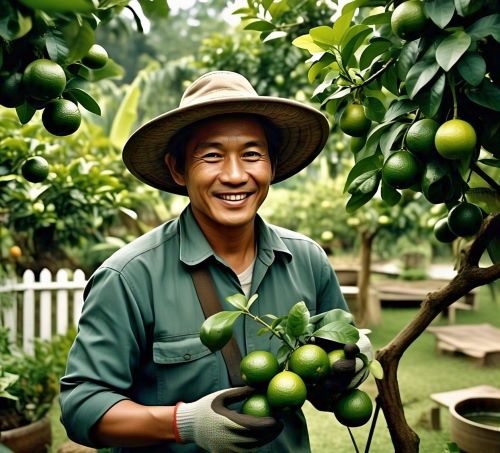
Recipe: Calamansi Juice
Ingredents required:
- 5 peaces of calamansi fruits
- 1 cup cold water
- 1 tbsp honey
How to Make:
- Squeeze juice, Mix well, add ice if desired, and enjoy your refreshing calamansi juice!
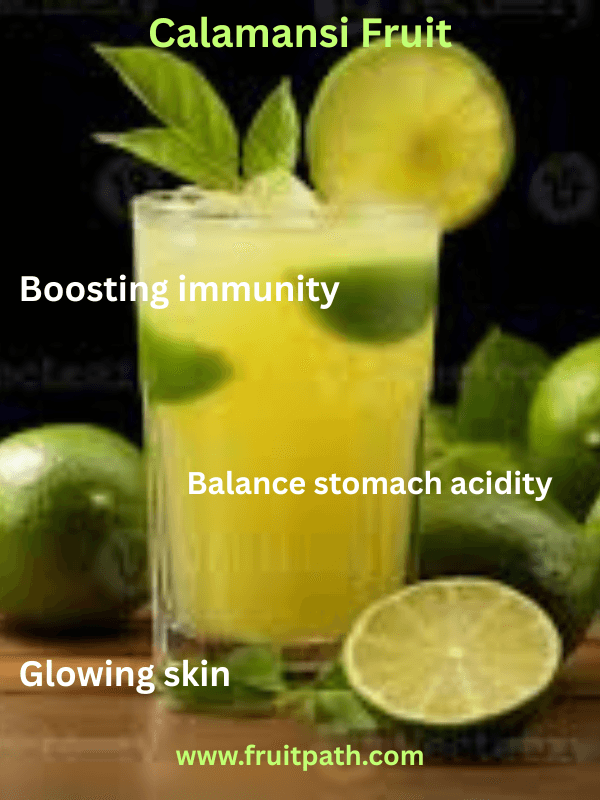
4. Cantaloupe (Cucumis melo var. cantalupensis)
Now we discover the cantaloupe fruit’s description, history, health benefits, nutritional facts, industrial uses, and a delicious recipe.
Description:
Another fruit that starts with C is Cantaloupe; it is a muskmelon-type fruit that is famous for its sweetness, juicy orange flesh, and distinctive netted rind. The fruit shape is typically round to slightly oval, weighing around 1 to 5 pounds. The outside skin of cantaloupe fruit is netted while the inside is vibrant orange central, filled seeds.
Origin and History
The fascinating history of the Cantaloupe fruit, according to fruit historians, is that it originated in South Asia or the African region. The fruit was mostly cultivated in the 17th century in an Italian village named Cantalupo near Rome. The fruit named cantaloupe came from the name of the village of Cantalupo. Today, the fruit is grown worldwide in countries like the United States, Turkey, China, Iran, and Egypt.
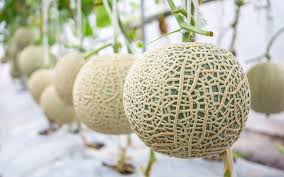
Trivia: Summer’s Favorite Melon
- 90 percent water, making cantaloupe fruit of the most hydrating fruits.
- Called “rockmelon” in Australia and New Zealand.
Nutritional Facts (Per 100g)
- Calories: 34 kcal
- Vitamin A: 3382 IU
- Vitamin C: 36 mg
Health Benefits
- Hydrates the body: Because Cantaloupe fruit has 90 percent water therefore it Prevents dehydration of the body. it also provides electrolytes like potassium, which help maintain fluid balance in the body.
- Supports skin and eye health: The fruit contains high vitamin A content, which supports skin freshness and eye health.
- Aids digestion: Contains fiber and digestive enzymes. Which are very important for the body’s needs.
Cantaloupe’s Industrial Uses: Healthcare and Beauty
Healthcare Industry
- Heart Health: Cantaloupe fruit contains Potassium, which regulates blood pressure. So many pharmaceutical companies are making capsules and tablets.
- Vision Support: The fruit contains Beta-carotene, which improves eye health. It supports retinal health, prevents night blindness, and decreases the risk of age-related macular degeneration (AMD), so companies make multivitamin blends and eye health capsules.
Beauty Product Industry
- Skin Hydration – Most beauty product-making companies use these fruit Extracts to make face masks.
- Anti-Aging Properties – companies used to make face beauty creams to reduce wrinkles.
- Hair Growth – Vitamin A promotes a healthy scalp and hair.
Cantaloupe furit’s Cultivation & Harvesting:
When we talk about the cultivation of Cantaloupe fruit, it is like a warm climate with temperatures around 24°C and 35 °C. For cultivation, the land soil preferred well-drained sandy loam; their seeds are sown directly into the field. The fruit needs regular watering, especially during the flowering and fruiting season.
The fruit takes 70 to 90 days from sowing to harvest. The harvesting process of fruit is by hand picking. Usually, farmers pick the fruit in the early morning, and after harvest, for the freshness of the fruit, it is necessary to store it at 2 to 5 degrees Celsius with 90 to 95 percent humidity conditions, which can be used for up to two weeks.

Recipe: Cantaloupe Smoothie
- 1 cup diced cantaloupe
- ½ cup yogurt
- 1 tbsp honey
- Blend everything until all ingredents mixed well now enjoy smoothie!
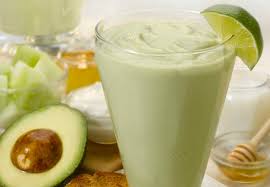
5. Cape Gooseberry(Physalis peruviana)
Let’s discover the cantaloupe fruit’s description, history, health benefits, nutritional facts, industrial uses, and a delicious recipe.
Description of Cape Gooseberry:
The fruit starts with c, the next is Cape Gooseberry, Also known as Goldenberry, Inca berry, Peruvian groundcherry, Poha (Hawaii), Uchuva (Colombia), and Aguaymanto (Peru), is a small, round orange fruit; its plant is a soft wooded perennial shrub, the fruit often grown as an annual in temperate regions.
The fruit plant height is around 1 to 3 feet tall, its leaves are heart-shaped and light green, its flowers are small ball-shaped with purple-brown spots at the center, the fruit size is about 1 to 2 Cm, and its fruit color is bright golden-yellow when ripe. The cape gooseberry fruit is inside a papery husk with a sweet-tart flavor, citrusy with hints of pineapple and tomato.
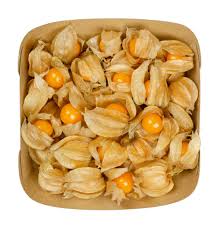
Cape Gooseberry Origin and History:
Cape Gooseberry fruit originates from high-altitude regions belonging to South America, Peru, and Colombia. It has been cultivated since Incan times for its superb medicinal and nutritional value.
Spanish and Portuguese explorers bring it to Africa, Europe, and Asia. Today, the fruit is grown worldwide, prized for its unique flavor and vibrant golden color.
Trivia: The Hidden Gem Fruit:
- Related to tomatoes and eggplants.
- The husk acts as natural protection, extending shelf life.
Nutritional Facts (Per 100g)
- Calories: 53 kcal
- Vitamin C: 11 mg
- Fiber: 3 g
Health Benefits of Cape Gooseberry Fruit:
- Rich in antioxidants, cape gooseberry fruit protects body cells from damage.
- Boosts immunity system: Cape fruit has excellent Vitamin C Strength, enhancing the body’s immunity system.
- Supports digestion: The fruit has high fiber values. Therefore, it helps to maintain an ideal digestive system.
Cape Gooseberry’s Industrial Uses: Healthcare and Beauty:
Healthcare Industry:
Many pharmaceutical companies use cape gooseberry fruit to make various medicines.
The fruit has a high amount of antioxidants, polyphenols, and withanolides, making it valuable in developing natural health supplements. The fruit is used in formulations to boost immunity, manage inflammation, and support liver health. Cape Gooseberry is used in traditional and modern herbal medicines.
Beauty Product Industry:
Several beauty manufacturing companies use this cape gooseberry fruit to make skin and beauty products.
- Skin Repair: The fruit cape gooseberry is used to make sunblock creams to protect the skin from sun damage.
- Hair Strengthening: Cape Gooseberry Extracts nourish hair follicles, which are used to make hair oils to strengthen and shine hairs.
Cultivation & Harvesting:
Regarding cultivation, Cape Gooseberry thrives in warm, frost-free locations with sandy or loamy soil that drains well. It is often propagated from seeds, which sprout in 1-2 weeks. The fruit usually requires Full daylight, do not forget frequent watering and mild organic fertilizer are necessary for plants.
When the papery shell becomes dry and light brown, and the berry becomes golden-orange, it means the fruit is usually ready to be harvested. Generally, the fruit is prepared for harvesting 70 to 100 days after transplanting. Harvesting is done by hand, usually every few days during peak season.
Recipe: Cape Gooseberry Jam
- ✔ 1 cup cape gooseberries
- ✔ ½ cup sugar
- ✔ 1 tbsp lemon juice
👉 Cook until thickened, then store in a jar!
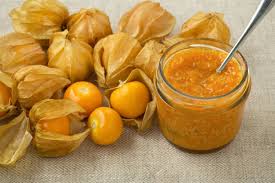
6. Carambola (Star Fruit)- Averrhoa carambola
Let’s discover the carambola fruit’s description, history, health benefits, nutritional facts, industrial uses, and a delicious recipe.
Description of Carambola Fruit:
Carambola, or star fruit, is a yellow-green tropical fruit with a star shape when sliced, with a juicy, crisp texture and a sweet-tart flavor. Star fruit has a sweet-tart flavor, similar to a blend of apple, grape, and citrus. People use star fruit both fresh and in culinary preparations like juices, salads, jams, and desserts.
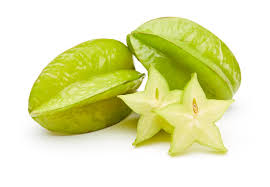
Carambola Origin and History:
The history of the fruit carambola indicates that it is native to Southeast Asia, specifically countries like Indonesia, the Philippines, Malaysia, and South China. The fruit has been in these regions for centuries and is deeply rooted in local diets.
The fruit later made its way through trade routes to other tropical and subtropical countries, India, Sri Lanka, and the Pacific islands. In the middle of the 19th century, the fruit made its way to South America, where it became very popular for gardening and commercial use. Its cultivation has expanded to include additional regions in the United States, such as Florida and Hawaii, as well as countries like Australia and parts of Africa.
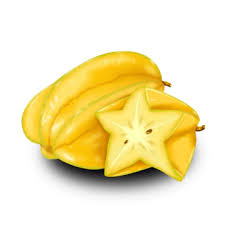
Trivia: The Star of Exotic Fruits
- Star Shape Magic: When sliced, carambola looks like perfect five-pointed stars, which makes it a popular decorative fruit for gourmet dishes and cocktails.
- You can use it in both sweet and savory dishes.
- Global Traveler: Though native to Southeast Asia, it’s now grown in tropical regions worldwide, including the Caribbean, Florida, and South America.
Nutritional Facts (Per 100g)
- Calories: 31 kcal
- Vitamin C: 34 mg
- Fiber: 2.8 g
Health Benefits of star fruit (carambola):
- Supports heart health: The meal is low in fat and sodium, with potassium that helps regulate blood pressure and heart function.
- Boosts immunity: Carambola is high in vitamin C, which boosts the immune system, helps fight infections, and promotes healthy skin.
- Aids digestion: The fruit is full of fiber, which is suitable for the digestive system.
Carambola’s Industrial Uses: Healthcare and Beauty Products
Healthcare Industry
There are several ways to prepare carambola for medicinal purposes: Anti-inflammatory and antioxidant medications
- Anti-aging, anti-diabetic, and cardiovascular supplements contain quercetin and polyphenol extracts. Researchers are currently investigating the neuroprotective properties of quercetin and polyphenol extracts; however, kidney patients should exercise caution as caramboxin may be harmful.
- Wound disinfectants and oral care products use the fruit’s oxalic acid and flavonoids, which have good antibacterial properties. Topical medicinal applications like wound-healing ointments are made from this fruit because it has vitamin C and antioxidant elements, which promote tissue repair.
Beauty Product Industry
- Brightening Serums & Creams—Vitamin C and AHAs (alpha-hydroxy acids) lighten dark spots.
- Hair Shine—Companies also use carambola fruit to make scalp treatment shampoos because they have antimicrobial properties that help decrease hair dandruff issues.
- Skin Hydration—The fruit extracts are used to make moisturizing lotions.
- Perfumes & Body Sprays—Carambola fruit is also used to produce a sweet, tropical scent and is used in organic fragrances.
Cultivation & Harvesting
The star fruit, carambola, grows best in tropical and subtropical regions with temperatures between 25 and 35°C and soil that drains well and has a hint of acidity. It is usually propagated via grafting, and trees are planted 6–8 meters apart.
When the fruits turn yellow with slightly green tips, we harvest them by hand-picking them or, to prevent damage, using clippers. Mature trees can produce 100–300 kg annually with the proper care.
Recipe: Star Fruit Salad
- 1 sliced starfruit
- 1 cup of mixed greens
- ½ cup pomegranate seeds
- 1 tbsp olive oil
- Toss everything together and serve fresh!
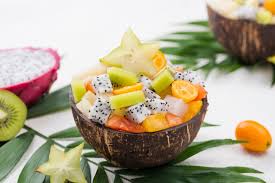
7. Cashew Apple (Anacardium occidentale)
Let’s know about the carambola fruit’s description, history, health benefits, nutritional facts, industrial uses, and a delicious recipe.
Description of cashew apple:
The cashew nut, the actual fruit of the cashew tree, is connected to the fleshy, pear-shaped pseudofruit known as the cashew apple. Although the cashew apple is technically an accessory fruit (the nut being the fruit), it has a soft, juicy texture, a sweet-tangy flavor, and a strong scent. When ripe, its skin is bright yellow to red, and its flesh is juicy but fibrous. In tropical countries like Brazil, India, and Africa, cashew apples are used in traditional remedies, juices, and preserves.

The Cashew Apple Origin and History:
Now it’s time to discover the cashew fruit’s origin. It is native to northeastern Brazil, where it grows in the tropical weather of the Amazon rainforest. The Brazilian tribes, such as the Tupi people, are the pioneers of this fruit; they used both the cashew apple and nut.
Firstly, in the 16th century, explorers of Portugal introduced it to Africa, India, and Southeast Asia, where this fruit reached high esteem and was placed as a cash crop. Today, other tropical region countries like Nigeria, Vietnam, and Tanzania have picked the cashew cultivation.
Trivia: The Forgotten Fruit
- The cashew nut is the seed, while the cashew apple is the swollen fruit stalk.
- It spoils quickly, within 24 to 48 hours, so it’s consumed chiefly fresh or juiced.
- Scientists now explore ways to upcycle it into nutraceuticals, biofuels, and vegan leather, giving this “forgotten fruit” a second chance.
Nutritional Facts (Per 100g)
- Calories: 53 kcal
- Vitamin C: 219 mg
- Fiber: 1.1 g
- Antioxidants: High
Health Benefits of Cashew Fruit:
- Rich in Vitamin C – Boosts immunity, promotes skin health and aids in collagen production for wound healing.
- High Antioxidant Content – Fights free radicals, reducing oxidative stress and chronic disease risk.
- Anti-Inflammatory Properties – Helps reduce inflammation, benefiting conditions like arthritis and digestive disorders.
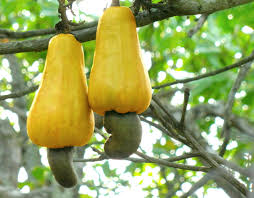
Cashew Apple’s Industrial Uses: Healthcare and Beauty:
Healthcare Industry:
The cashew apple is rich in vitamin C, antioxidants, and polyphenols, making it valuable in nutraceuticals and functional foods. Its high tannin and carotenoid content supports immune health, wound healing, and anti-inflammatory treatments. Fruit extract is used in dietary supplements to combat malnutrition and boost immunity. With its antimicrobial properties, the juice is studied to prevent infections and improve digestion. Fermented cashew apple juice also produces bioactive compounds with potential anti-diabetic and anti-cancer effects.
Uses in Beauty & Cosmetics:
In the beauty industry, cashew apple extracts are used in anti-aging creams and serums due to their high antioxidant content. The fruit’s natural acids act as gentle exfoliants in skincare, promoting brighter, smoother skin. This fruit has fantastic hydrating properties, making it a key ingredient in moisturizers, toners, and face masks. Cashew apple oil, rich in fatty acids, is used in hair care products to strengthen and add shine. Additionally, its astringent and antibacterial benefits help in acne treatments and natural cosmetic formulations.

Cultivation & Harvesting:
If you want to cultivate cashew apples, they are native to tropical climate regions because the fruit needs well-drained, sandy loam soil in a tropical climate. The rainy season is good to start. Seeds or grafted saplings are planted.
Young trees need regular watering and fertilization in the early stages for the first 1 to 2 years. Flowering begins at 3 to 5 years, with the cashew apple developing after the nut matures.
Harvesting starts when the cashew apple turns yellow, red, or pink and feels slightly soft. Workers hand-pick the ripe apples to prevent damage, ensuring the attached nut is carefully separated. Remember that The apples must be processed quickly, as they spoil within 24–48 hours after harvesting. Meanwhile, the nuts are sun-dried for 2–3 days before shelling to remove toxic resin.
Recipe: Cashew Apple Juice
- 2 cashew apples.
- 1 cup water.
- 1 tbsp honey.
- Blend everything and strain before drinking!
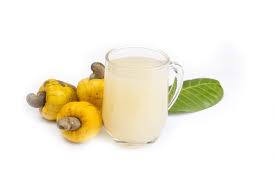
8. Cherimoya (Annona cherimola):
Let’s know about the cherimoya fruit’s description, history, health benefits, nutritional facts, industrial uses, and a perfect recipe.
Cherimoya Fruit Description:
Cherimoya is the next fruit on our list, and it starts with the letter C. People commonly call it a custard apple because of its texture. Cherimoya belongs to the Annonaceae plant family, and the fruit is highly valuable because of its creamy, sweet flesh and remarkable flavor. If we look at its size, the fruit is typically 10 to 20 cm long, with rugged, turning brown skin when ripe. The fruit contains large black seeds.
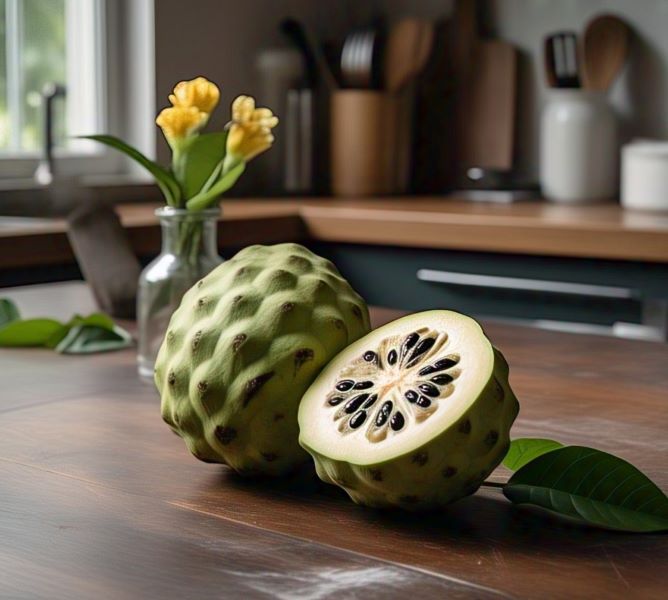
Origin and History of the Fruit:
The story of Cherimoya starts thousands of years ago. Its name comes from the Quechua words “chiri” (cold) and “muya” (seed), referring to its ability to grow at high altitudes. The fruit historians believed that this fruit originated in the Andean valleys of Peru, Colombia, Ecuador, and Bolivia. In this region, they have been cultivating this fruit since ancient times by indigenous civilizations like the Incas.
European countries became familiar with this fruit in the 16th century when Spanish colonizers introduced it. In later centuries, cherimoya fruit spread worldwide in tropical and subtropical regions, like Southern California, Central America, Southeast Asia, and the Mediterranean. Today, if we query the top producers of cherimoya in the world, Spain and Peru are still at the top of the list; in these regions, they call this fruit peral of the Andes:.
Trivia: The Ice Cream Fruit:
- The cherimoya Tastes like a mix of banana, pineapple, and mango.
- The seeds are toxic if crushed, so they must be removed before consumption.
Nutritional Facts (Per 100g)
- Calories: 75 kcal
- Carbohydrates: 18 gm
- Protein: 1.6 g
- Fat: 0.7 g
- Vitamin C: 12.6 mg
- Vitamin B6: 0.2 mg
- Potassium: 287 mg
- Magnesium: 17 mg
- Iron: 0.3 mg
- Calcium: 10 mg
Health Benefits
- May Aid Brain Health: contains B vitamins (B6, folate) that support cognitive function.
- Enhances Immunity: vitamin C strengthens the immune system and aids collagen production.
- Regulates blood pressure: The fruit contains High potassium, which maintains BP(blood pressure).
- Supports immune health: The cherimoya fruit contains antioxidants, which help combat oxidative stress and inflammation.

Cherimoya’s Industrial Uses: Healthcare and Beauty:
Cherimoya is not only a delicious fruit, but it is also blessed with many valuable elements, leading the pharmaceutical, nutraceutical, and cosmetic sectors to use it in their products.
Healthcare Industry:
- Anti-Inflammatory Factors: The cherimoya fruit adds superb value to human lives. It’s Extracts from leaves and flesh are pharmaceutical manufacturers for their potential in reducing oxidative stress and inflammation, possibly aiding in chronic disease prevention.
- Dietary Supplements: Cherimoya fruit is rich in vitamin C, fiber, and potassium, and it’s used in nutraceuticals for Immunity, digestion, and heart health.
- Antifungal activity: Cherimoya is helpful in natural disinfectants or topical treatments.

Beauty Product Industry:
- Brightening Treatments: Cherimoya’s Extracts are usually used to make face masks and toners for a radiant complexion.
- Moisturizing Agents: The fruit’s natural oils and fatty acids are used in hydrating lotions and hair conditioners.
- Anti-Aging Creams & Serums: High because the fruit has antioxidant content (vitamin C, flavonoids), which adds value to our lives regarding combating free radicals, reducing wrinkles, and promoting collagen production.
Cultivation & Harvesting
Naturally, cherimoya trees love subtropical and tropical climates, especially altitudes around 1400 to 2000 meters, where conditions are warm days and cool nights. The fruit trees ideally require moderate rainfall or an irrigation system for fruitful results. Surprisingly, cherimoya trees are very sensitive to frost and strong winds, so they are usually in sheltered locations. The cherimoya tree naturally bears fruit in three to four years.
Cherimoya fruit harvesting is usually done by hand-picking when it matures but is still firm as it ripens from the tree; the harvesting season starts five to eight months after flowering, and the ideal harvesting season of the fruit, depending on the regional atmosphere, ideally ends in the Fall to early spring seasons. After harvest, the fruits are carefully handled to prevent bruising and the fruit stored at room temperature to ripen fully, wich takes (2 to 5 days).
Recipe: Cherimoya Smoothie:
1 ripe cherimoya (peeled, seeded, flesh scooped)
- 1 frozen banana (for creaminess)
- ½ cup coconut milk (or almond milk)
- ½ cup yogurt.
- 1 tsp honey or maple syrup (optional for extra sweetness)
- ½ tsp vanilla extract
- Ice cubes (optional for thickness)
- Toppings: Chia seeds, shredded coconut, or mint leaves
Instructions to make:
- Prep the cherimoya: Cut in half, scoop out the flesh (discard seeds), and add to a blender.
- Blend: Add banana, coconut milk, yogurt, honey, and vanilla. Blend until smooth.
- Adjust consistency: Add ice for thickness or a splash of milk for a lighter texture.
- Serve immediately in chilled glasses, topped with chia seeds or coconut flakes.
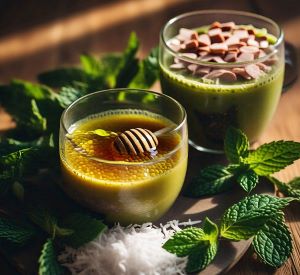
9. Cherry (Prunus avium)
Description
Cherries are small, round fruits with a sweet or tart flavor. They are available in red, black, and yellow varieties.
Origin and History of cherries:
The cherry fruit is native to Europe and Asia, where it originates between the Black and Caspian Seas. Historical cultivation evidence dates back to ancient times, and the fruit has been cultivated for over 2000 years. The European importer introduced cherries to North America in the 17th century. Today, this fruit is grown worldwide in temperate climates. The United States, Turkey, and Iran are among the top producers of this fruit.
Trivia: Nature’s Candy
- A single cherry tree can produce 7,000+ cherries per season!
- Contains melatonin, which promotes better sleep.
Nutritional Facts (Per 100g)
- Calories: 50 kcal
- Vitamin C: 10 mg
- Fiber: 1.6 g
- Antioxidants: High
Health Benefits
Promotes sleep: The Cherry fruit is a Natural source of melatonin.
Reduces inflammation: Rich in anthocyanins, which are beneficial for reducing inflammation issues.
Supports heart health: Helps lower blood pressure.
Cherry’s Industrial Uses: Healthcare and Beauty:
Cherry fruit is not just a sweet and delicious fruit for eating and enjoying; it is also used for many beneficial things, such as Herbal, pharmaceutical, and beauty products.
Healthcare Industry
- Joint Pain Relief: The cerry fruit is used in pain relief medicines to reduce arthritis symptoms.
- Improves Sleep Quality: Natural melatonin source.
- Heart Health: Lowers bad cholesterol.
Beauty Product Industry
- Brightens skin – Rich in vitamin C, it is used to make brightening products.
Reduces acne – Fights free radicals.
Hair Shine – Cherry extract is used in hair serums.

Cherry fruit Cultivation & Harvesting:
The Cherry tree cultivated in a well-drained, fertile soil it requires a cold winter season for proper dormancy, but the location should be sunny. The commercial growers graft trees onto rootstocks to control tree size and best fruit results. The cherries are typically harvested at the start of the summer season, when the fruits reach their full color and sweetness. The trees begin bearing their fruit around 3 to 5 years after planting.
Recipe: Cherry Chia Pudding
- 1 cup fresh or frozen cherries (pitted)
- 1 cup almond milk (or any milk of choice)
- 3 tbsp chia seeds
- 1 tbsp honey or maple syrup (optional)
- ½ tsp vanilla extract
- Toppings: extra cherries, nuts, coconut flakes
Instructions on how to make it:
- Blend cherries with almond milk until smooth. Strain if desired for a smoother texture.
- Put in a jar, mix the cherry milk with chia seeds, sweetener, and vanilla. Stir well.
- Refrigerate for at least 4 hours (or overnight) until thickened.
- Stir before serving, then top with fresh cherries, nuts, or coconut.
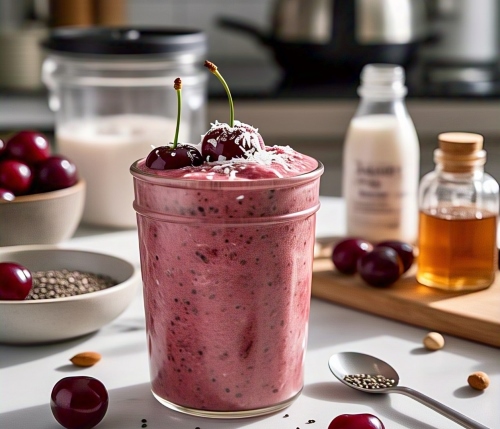
10. Clementine (Citrus × clementina)
Description of clementine Fruit:
Clementines are small, seedless oranges with a sweet, juicy taste. They are often called “Christmas oranges” because they are harvested in winter. It has a smooth, glossy, deep orange skin that peels easily, making it a convenient and popular snack, especially for children. Clementines are typically juicy and bursting with a bright, tangy-sweet flavour.
Clementine Fruit’s Origin and History:
Clementines originated in Algeria in the early 20th century, but the interesting fact about this fruit name is that it was given by a French missionary, Father Clement Rodier, who either discovered or bred the hybrid between a sweet orange and mandarin. Because of its seedless segments and easy-to-peel skin, the clementine fruit spread quickly around regions like the Mediterranean and Europe.
The United States regions of California and Florida became familiar with this fruit in the mid-19th century; nowadays, they are the key producers of this fruit. If we talk about this fruit’s top producer, Spain dominates global cultivation.

Trivia: The Easy-Peel Orange:
- Unlike regular oranges, clementines are effortless to peel.
- Often found in children’s lunchboxes due to their sweetness and ease of eating.
Clementine Fruit Nutritional Facts (Per 100g):
- Calories: 47 kcal
- Vitamin C: 48 mg
- Fiber: 1.7
- Water: 86.58 g
- Carbohydrates:11.54 g
- Protein: 0.85 g
- Fat: 0.15 g
Health Benefits of Clementine Fruit:
- Boosts immunity: Clementine fruit is High in vitamin C content, which boosts your immune system. A single clementine fruit provides you with 40% Vitamin C of your daily body needs.
- Promotes collagen production: Supports healthy skin, fresh and glowing skin.
- Aids digestion: Contains natural fiber, which helps prevent constipation and promotes regular bowel movement.

Clementine’s Industrial Uses: Healthcare and Beauty:
Like other fruits, Clementine is also used in many beauty products and pharmaceutical products.
Clementine fruit use in the Healthcare Industry:
Clementine fruit is used in immune-boosting supplements and flu remedies. The essential oils from its peel are used in aromatherapy and natural medicines.
Clementine in the Beauty Product Industry:
Clementine fruit is also used in beauty products. It’s known for its Vitamin C, which brightens skin. Fruit extracts are used in facial serums and moisturizers.
The fruit is also found in perfumes, beauty soaps, and other products.
Clementine fruit Cultivation & Harvesting:
Clementines grow best in warm, sunny places with good drainage. They are often grafted to ensure quality. Harvest time is in winter, when they are sweetest.
Harvesting is done by hand to protect the fruit. Workers carefully twist or clip the stems to keep the peel intact.
Recipe: Clementine Infused Water:
Ingredients:
- 1 to 2 clementines (washed and thinly sliced or peeled and segmented)
- 4 to 5 fresh mint leaves (optional but refreshing)
- 2 to 3 slices of cucumber (optional for a spa-like twist)
- 2 to 3 cups of cold filtered water
- Ice cubes (as desired)
How to make:
Slice the clementines thinly or break them into segments. Gently crush the mint leaves to release their oils.
In a large glass, mason jar, or water bottle, add the clementine slices/segments, mint leaves, and cucumber slices (if using).
- Now, pour cold filtered water over the ingredients, which are ready to make an infusion.
- Prep Time: 5 minutes
- Chill Time: At least 2 hours (or overnight for best flavor)
- Serves: 1–2 (scale as needed)


